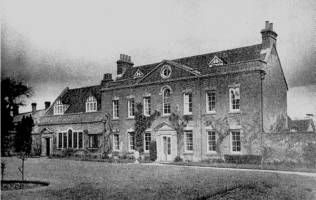
The Rise and Fall of Finmere House
Newsletter 11: July 1998
Finmere’s Threatened Heritage
Finmere House has long been recognised as an important historic building....being listed as a Grade 2 historic building. Below we trace the history of the House and report on its decline.

Finmere House in 1951
The Origins of Finmere House
Finmere manor, which included most of the land in the parish, was sometimes owned and managed as single estate and at other times divided into several estates. One estate centre was at Bacon’s House on the River Ouse near Water Stratford; another at Finmere House in the village.
The oldest surviving part of Finmere House is now known as the Tudor House. It is pictured below in the early years of this century.
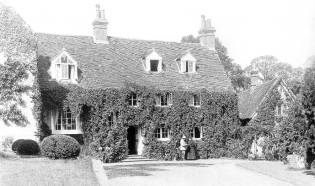
The earliest house on this site may have been built by Edmund and Elizabeth Hogan who inherited one third of Finmere manor in 1559. The current Tudor House, however, appears to be a seventeenth century building. The property passed through five generations of the Hogan family before being bequeathed to Frances James.
John Pollard’s Aggrandisement
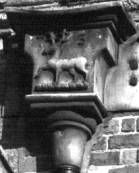 At Frances James' death in 1739, her estate land passed to Nathaniel Bacon. Finmere House itself had been sold in 1738 to John Pollard from Leckhampstead. He was a man of some importance and previously a Sheriff of Buckinghamshire. Pollard’s first task was to construct the stone-built south wing with its handsome brick façade (above). The rain water heads (right) still bear his crest, a gazing stag, and the date 1739. At this time or later, a stable wing was added; the entrance is now known as the Coach House.
At Frances James' death in 1739, her estate land passed to Nathaniel Bacon. Finmere House itself had been sold in 1738 to John Pollard from Leckhampstead. He was a man of some importance and previously a Sheriff of Buckinghamshire. Pollard’s first task was to construct the stone-built south wing with its handsome brick façade (above). The rain water heads (right) still bear his crest, a gazing stag, and the date 1739. At this time or later, a stable wing was added; the entrance is now known as the Coach House.
Later Owners
After the death of John Pollard in 1761 and his wife in 1763, the family let the House. John Newman, from Bedgrove, near Aylesbury, was the first tenant. He was followed, after 1820, by Henry Whately Chandler from Mixbury. After 1830 Finmere House was occupied by two brothers, Doctors James and Charles Clark. James rebuilt the church clock (Newsletter 5) and improved village water and sewage facilities (Newsletter 8).
Later in the 19th century, ownership passed first to the Hall family, and then to the Symes-Thompsons, who added the music room in 1890 (to the left of the House in the picture above left). In 1962, the house was purchased by the Flowers family, who undertook significant repairs and restoration work. Their alterations included the construction of the Red Hall (below) with its elegant balustraded staircase. The Flowers then used the House to sell expensive antiques — it is said that everything in the House was “for sale”!
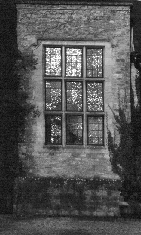
In 1977, the property was divided into the present three plots. The original house became known as Tudor House, the former stable entrance is the Coach House and the name Finmere House has been preserved for Pollard’s south wing.
The Decline of Finmere House
During more recent years, Finmere House had been left empty. Despite internal damage from burst pipes, the structure remains sound and the grounds are now being maintained. The architectural details of the 1739 facade, however, are in an appalling state and the rate of decay has notably increased in the past few years. Without urgent remedial action, it is likely that there will be little of interest from John Pollard’s handsome extension worth preserving into the next millennium.
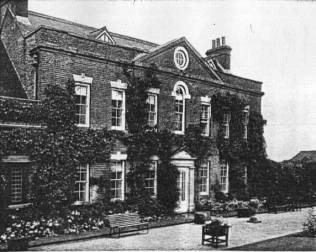
Finmere House in 1939

… and in 1998
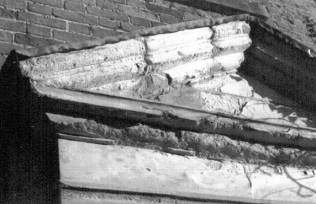
An example of the extensive stonework decay
Action for Finmere House
The house is currently (2011/12) under rennovation. (This paragraph has been edited in Jan 2012)
Blomfield’s History of Finmere
We have received an excellent response to our pre-publication offer for a new edition of Blomfield’s 1886 History of Finmere. The book will printed during August and available at the village hall from 5.00pm on Saturday 5 September. Please come along and collect your copy; wine and cheese will be available. Other subscribers will receive their copies shortly after the launch.
Elsewhere …
Two apologies are in order. In the last newsletter, we slipped a century. The second burst of railway mania was over and Britain had nearly six thousand miles of railways by the 1840s, not the 1940s! Earlier we mistyped Wilfred’s surname as Davies (it is Davis). Our apologies. Please feel free to correct all our errors and help us record history accurately.
Coffee Morning
We would like to thank all the villagers who attended the coffee morning on 4 April for providing a wealth of anecdotes and information on village life earlier this century. Recollections of the Trumpet Clock were of particular interest. The clock, built by John Sikes for the Clark brothers in the nineteenth century appears to have been originally installed in Finmere House, and later moved to Water Stratford. It was last seen, in disrepair, at Radclive Mill in the 1970s. (This paragraph has been edited in Jan 2012)
Acknowledgements
Our particular thanks to Paul Woodfield for his advice on the dating, development and condition of Finmere House. Also thanks to Carol Barker for photographs and to Sheila and Ian Macpherson for help in compiling this Newsletter. Many people have helped in History Society research, events, publication of this Newsletter and republication of Blomfield. Our thanks to them all.